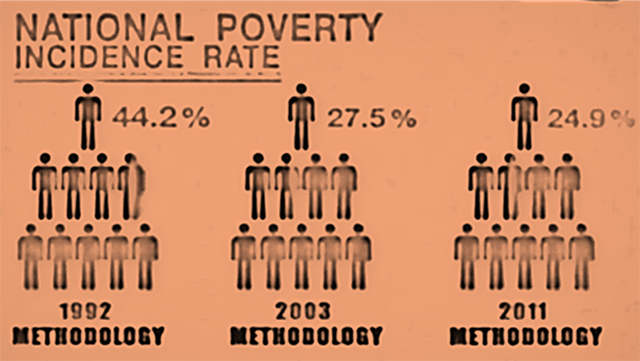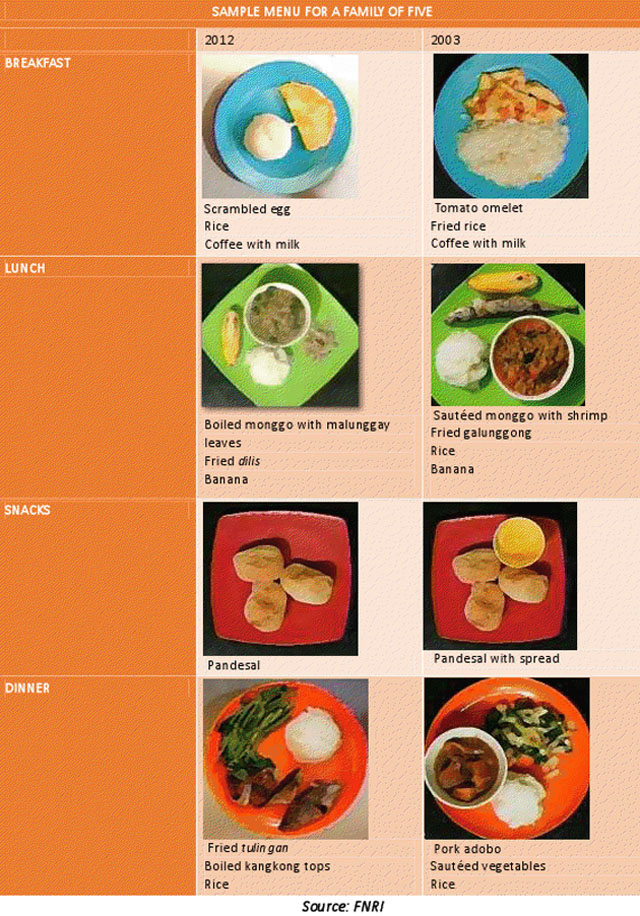Filtered By: Topstories
News
Tweaked food threshold distorts PHL poverty picture
If Mang Andoy, a minimum-wage factory worker in Metro Manila, earns P426 a day for his family of five, does that make him wealthy?
According to a National Statistical Coordination Board (NSCB) poverty indicator, though he may not be called wealthy, Mang Andoy’s income does not place him among the ranks of the poor, either.
The NSCB explained that there are two ways of calculating whether someone is poor – the food and non-food threshold.
The food threshold refers to the income of a family or an individual to buy the most basic of food items.
Basic non-food items include expenditure on education, health, transportation and communication, non-durable furnishings, repairs and rent for shelter. Excluded from the non-basic expenditures are such items such as alcoholic beverages, tobacco and recreational activities.
If you meet these thresholds, you are not poor.
The Food and Nutrition Research Institute (FNRI) and NSCB came out with a P172-a-day food bundle that satisfies the nutritional requirement of a five-member Filipino family for a day. This is now the new food threshold.
“Ang kailangan lang ng isang pamilya na may limang miyembro ay P172 para mabili niya ‘yung minimum food requirements na low-cost but at the same time, hindi nasasakripisyo ang nutritional requirements na kailangan ng isang indibidwal,” said Jessamyn Encarnacion, Director of NSCB’s Social Statistics Office in an interview with GMA News.
Given that Mang Andoy’s daily wage is twice as large as the food threshold, he and his five-member family should be pleased to know that they aren’t as poor as they thought they were.
“Forced diet”
According to non-profit development organization IBON Foundation, the new food bundles the NSCB uses aims to determine the acceptable food threshold across the different provinces of the country.
However, they also said in a statement, “It [the food threshold] is derived using the test of revealed preference, a tool prescribed by the World Bank which would supposedly reflect actual spending patterns on food. This however puts the methodology into question because the result may reflect not necessarily the pattern of preference but that of spending for cheaper food forced on Filipinos because of their poverty.”
Ibon Foundation Executive Editor Rosario Bella Guzman said, “Pag inilagay mo sa barest existence ang iyong pamantayan o ‘yung sinasabing isang kahig, isang tuka…yung ganoong klaseng pamantayan ng poverty, you will come up with a very low poverty incidence.”
Also, the National Nutrition Council says the new food bundle is inadequate to support the health of a Filipino family.
NNC nutrition officer Hygeia Ceres Gawe said, “Diyan sa food menu na ‘yan, wala tayong gaanong nakikitang masyadong rich in fat. Except ‘yung sa isang diyang meal na mayroong pritong isda. Pero bukod doon, the rest are boiled.”
“May kulang tayo like iron, niacin and thiamin doon sa food menu. Pero, ‘yan, dahil ‘yan ay typical menu lang… kumbaga, average,” Gawe added.
The FNRI requires “100% of the Recommended Energy and Nutrient Intakes (RENI) requirement for energy (2000 kilocalories on the average) and 80% of the RENI requirement for other nutrients.”
Be that as it may, Guzman said, “Halos hindi mo na masasabing nutritious talaga ito.... It is a forced diet kasi nilagyan siya ng price that is the cheapest in the market.”

Revision after revision
The food threshold has been revised three times in the past 10 years. The NSCB said this was done in order to effect “refinements” that made the measurements more accurate.
For example, in 1992, Encarnacion said they had to take out tobacco and alcoholic beverages from the basic expenditures.
“There was that perception na baka nao-overestimate ang poverty incidence natin at that time,” said Encarnacion.
Citing a 1992 study prepared by former NSCB Exec. Dir. Romulo Virola and Asian Development Bank’s Abuzar Asra, “Comparative Study of Poverty Assessment: Indonesia and the Philippines,” Encarnacion said that almost all economic indicators of the two countries are the same save for the poverty statistics.
“When we looked at the poverty statistics, sobrang taas nung sa Philippines. Doon nakita na in poverty monitoring, isinasama pala natin sa basic expenditures ang alcoholic beverages and tobacco.”
In 2003, the NSCB had to again revise the methodology in order to accommodate the differences of prices and food availability per region.
“Basically, sa 2003, mayroon tayong regional food bundles and then yung food bundles na iyon ang ina-apply natin to all the provinces within that region but we used provincial prices to cost these bundles,” said Encarnacion.

In 2011, NSCB “refined” the methodology for the third time to “better identify” the poverty threshold with the use of provincial poverty statistics and provincial food bundles as standard.
“Para at least when you are computing provincial poverty statistics with the use of provincial food bundle, mas nakukuha n’yo yung locally available food within that province and at the same time nakukuha ‘yung eating patterns within that province,” explained Encarnacion.
However, critics said that each time the government revised the food bundles and the food threshold for poverty, the poverty incidence rate in the country declines.
From 2000 until 2009, the number of poor Filipinos decreased by at least 5.03 million.
IBON Foundation’s Guzman said, “The accuracy of the poverty measurement is based on a standard that we do not adhere to.”
“Ang ginagamit kasi natin ay ang pinakamababang pamantayan at nag-iilusyon tayong kaunti lang ang mahirap,” She added, “We at IBON have been saying that the standard that must be used in measuring poverty or the threshold that must be set must be based on decent living. Decent living means it must cover for basic social services, for basic human needs, and rest and recreation.”
She also noted that the poverty thresholds the government now employs only favor the foreign investors.
“Kasi walang magtitiwala sa iyong investors if you said that such and such are your 70 percent of your population is below poverty line,” said Guzman, “The government is not lying but it is sacrificing the chance to set a decent standard so that it can come up with decent policy.”
“By doing so, you have the least effort for policy-making,” she added. — Shai Panela/DVM/TJD, GMA News
More Videos
Most Popular




